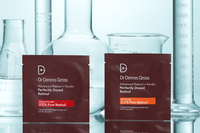Blue LED for Skin: What is Blue Light Therapy for Skin & Its Benefits
5 min

Fun fact: While light-emitting diodes (aka LEDs) may look like tiny, colored lightbulbs, they’re actually semiconductors that produce light when electric current runs through them. LEDs are available across a spectrum of shades, from invisible infrared to red and blue. An LED’s color and wavelength correspond to the energy level it emits. Blue LEDs are often used as part of an anti-acne protocol because they destroy the P. acnes bacteria that contributes to a breakout.
How do blue LEDs work?
Blue LEDs have a wavelength of 400 to 470 nanometers. As a result, they only get as far as one millimeter (usually less) into skin, which is the depth of the epidermis. Once they’re there, they essentially trigger P. acnes bacteria to self-destruct. This is a welcome development for anyone who’s struggling with blemishes (either the occasional breakout or more persistent pimples).
Blue light has been in the news a lot as we spend more time in front of our electronic devices. There’s growing concern that the blue light thrown off by our phones and computers may be generating free radicals that lead to collagen breakdown. You might be asking if using blue LEDs could eliminate a blemish, but produce a wrinkle. It’s a fair question. However, you can rest assured that controlled blue LED treatments are all reward, no risk. Blue light comes in many wavelengths. The wavelength used in blue LEDs for acne only impacts P. acnes bacteria—nothing else. So there’s no need to stress (which is good, since stress can also contribute to breakouts).
What are the benefits of blue LEDs?
Clearer skin. No P. acnes bacteria means one less thing to feed a growing pimple. Blue LEDs also have the added benefit of helping to regulate skin’s natural oil production, always helpful when you’re trying to quash an acne outbreak. Another plus to using blue LEDs to treat acne is that unlike topical acne treatments, which can sometimes dry out skin as they clear it, blue LEDs have no such side effects. They get rid of P. acnes bacteria, and that’s it.
In-office versus at-home—which blue LED treatment is for you?
Consistency is the byword for blue LED skin-treatment success. It’s not a one-and-done procedure. While you could conceivably go to your dermatologist’s office daily for a dose of blue LEDs, at $25 to $85+ a pop (depending on where you’re located), that expense is going to add up fast. And be honest—if you’re dealing with a monster breakout, don’t you want the satisfaction of being able to treat it basically around the clock (as opposed to once a day)? For that reason, an at-home blue LED device is likely your best bet. And while those may seem like a significant up-front investment (considering that some can cost as much as $495 or more), in the long run, you’ll find that your DIY purchase was worth the money.
But honestly, do blue LEDs really work?
Yep. Numerous peer-reviewed, published clinical studies touting blue LEDs’ efficacy can’t be wrong. If you’re diligent and consistent in using your at-home tool, acne improvement is practically guaranteed. But with so many blue LED devices on the (unregulated) market, it’s prudent to take steps to ensure you’re getting the largest return on your investment.
To guarantee that the promises on the package are delivered by the device inside, only purchase a device that’s been FDA cleared. (Cocktail party conversation starter: Unlike drugs, which get FDA approval, devices can only be FDA cleared.) FDA clearance confirms that the LED wavelengths, colors, and claims have been verified, which will give you one less thing to stress about.
Discover Dr. Dennis Gross LED Skincare
For more skincare tips and insight on the world of LED from the experts at Dr. Dennis Gross, check out our blog’s newest content. Shop the collection of Dr. Dennis Gross bestselling skincare backed by dermatologists and our line of at-home skincare devices.
Written By
Kayla Kernel
Kayla is a Medical Esthetician with 10+ years of experience. Growing up, Kayla struggled with cystic acne and scarring. This experience drives her passion to help others on their skincare journey. Kayla specializes in all skin types, tones, and ages.
Read More from Kayla Kernel
Written By
Kayla Kernel
Kayla is a Medical Esthetician with 10+ years of experience. Growing up, Kayla struggled with cystic acne and scarring. This experience drives her passion to help others on their skincare journey. Kayla specializes in all skin types, tones, and ages.
Read More from Kayla KernelRelated Articles
-

author-kayla-kernel, dehydrated-skin, dry-skin, hyaluronic-acid, pdp-hyaluronic-booster, pdp-hyaluronic-cleanser, pdp-hyaluronic-moisturizer, skin-and-deeper March 11, 2024 — 6 minutes
What is TEWL: Causes & How to Prevent It with Skincare
by Kayla Kernel
-

author-kayla-kernel, pdp-silk-pillow-bundle, retinol, skin-and-deeper, sleep February 08, 2024 — 4 minutes
Introducing the Dr. Dennis Gross Skincare x Slip collaboration!
by Kayla Kernel
-

author-kayla-kernel, pdp-retinol-pd-treatment, retinol, skin-and-deeper January 29, 2024 — 9 minutes
It’s Here: Dr. Dennis Gross Advanced Retinol + Ferulic Perfectly Dosed Retinol
by Kayla Kernel
Keep Reading
Stay up to date on the latest advice from our team of skincare experts.
Sign up to receive a monthly digest of skincare, wellness, and lifestyle tips.






